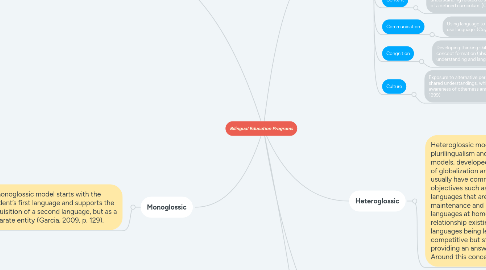
1. Monoglossic
1.1. A monoglossic model starts with the student’s first language and supports the acquisition of a second language, but as a separate entity (Garcia, 2009, p. 129).
1.1.1. Subatractive
1.1.1.1. Submersion
1.1.1.1.1. Students learn a language but do not have support in L2 to acquire (sink or swim.)
1.1.1.2. Transitional
1.1.1.2.1. Students learn a language in 3rd grade, but only in L2. Learning occurs almost always in L2 since the use of L1 occurs in a short period.
1.1.1.3. Learning a second language to the deteriment of the first language, especially if the first language is a minority language.
1.1.2. Additive
1.1.2.1. Maintenance
1.1.2.1.1. The student leanrs L2 while mainting L1, to guarantee its survival. They use L1 as the language of instruction, and progressively L1.
1.1.2.2. Prestigious or Elite
1.1.2.3. Immersion
1.1.2.3.1. Early
1.1.2.3.2. Delayed
1.1.2.3.3. Total
1.1.2.3.4. Patial
1.1.2.4. The language is separated. The aim is to develop proficiency in two languages.
1.1.3. Languages are independent.
2. Ofelia García - Translanguaging: Shifting the View from Languages to Speakers
3. Language Policies
3.1. 1. To preserve some languages.
3.2. 2. To promote bilingualism.
3.3. 3. To favor certain foreign languages over others.
3.4. Language Policies in Education
3.4.1. Determine the status or role of the language and do not approve them in the curriculum if they don't accomplish the status or hours.
4. CLIL
4.1. https://image.slidesharecdn.com/formacingepcairatupload-160209110724/95/whats-clil-1-638.jpg?cb=1455016133
4.2. To use CLIL, learning content is as important as learning a language. In the long run, students need to learn both content and new language but not in separate classes. (Montalto et al. The CLIL Guidebook: 7)
4.3. Content
4.3.1. Progression in knowledge, skills and understanding related to specific elements of a defined curriculum. (Coyle, 1999)
4.4. Communication
4.4.1. Using language to learn whilst leaning to use language. (Coyle, 1999)
4.5. Congnition
4.5.1. Developing thinking skills which link concept formation (abstract and concrete), understanding and language (Coyle, 1999)
4.6. Culture
4.6.1. Exposure to alternative perspectives and shared understandings, which deepen awareness of otherness and self. (Coyle, 1999)
5. Heteroglossic
5.1. Heteroglossic models are related to plurilingualism and translanguaging. These models, developed out of the complexity of globalization and global understanding, usually have common sociolinguistic objectives such as the revitalization of languages that are likely to disappear, the maintenance and development of minority languages at home or the fact that the relationship existing between the different languages being learned must not be competitive but strategic with a view to providing an answer to functional needs. Around this conception.
5.1.1. Recursive
5.1.1.1. Immersion Revitalization
5.1.1.2. Developmental
5.1.2. Dynamic
5.1.2.1. Two-Way Immersion
5.1.3. Languages are not independent. Herrera and Cook (2020) write in a paragraph, citing Dr. Ofelia, that we use language and we learn it, through practice in specific social contexts. Electronic portfolio.
